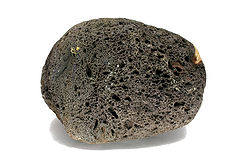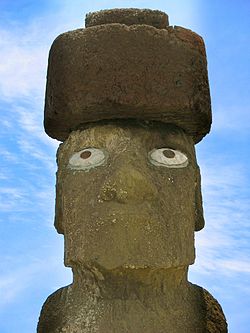Scoria
 From Wikipedia - Reading time: 9 min
From Wikipedia - Reading time: 9 min
This article needs additional citations for verification. (September 2010) |

Scoria or cinder is a pyroclastic, highly vesicular, dark-colored volcanic rock formed by ejection from a volcano as a molten blob and cooled in the air to form discrete grains called clasts.[1][2] It is typically dark in color (brown, black or purplish-red), and basaltic or andesitic in composition. Scoria has relatively low density, as it is riddled with macroscopic ellipsoidal vesicles (gas bubbles), but in contrast to pumice, scoria always has a specific gravity greater than 1 and sinks in water.
Scoria may form as part of a lava flow, typically near its surface, or as fragmental ejecta (lapilli, blocks, and bombs), for instance in Strombolian eruptions that form steep-sided scoria cones, also called cinder cones.[1] Scoria's holes or vesicles form when gases dissolved in the original magma come out of solution as it erupts, creating bubbles in the molten rock, some of which are frozen in place as the rock cools and solidifies. Most scoria is composed of glassy fragments and may contain phenocrysts. A sample from Yemen was mainly composed of volcanic glass with a few zeolites (e.g., clinoptilolite).[3]
The geological term cinder is synonymous and interchangeable with scoria, though scoria is preferred in scientific literature.[2][4] The word comes from Greek σκωρία, skōria, rust. In earlier terminology, scoria was usually defined with a size range, e.g. 2 to 24 mm (0.079 to 0.945 in) in diameter, but neither color nor composition was typically a part of the definition.[5][6] During the 1980s, the size range disappeared from the definition, and a requirement was added that scoria be black or reddish in color and/or mafic in composition.[1]
Comparisons
[edit]Scoria differs from pumice, another vesicular volcanic rock, in having larger vesicles and thicker vesicle walls, and hence is denser. The difference is probably the result of lower magma viscosity, allowing rapid volatile diffusion, bubble growth, coalescence, and bursting.
Formation
[edit]
As rising magma encounters lower pressures, dissolved gases are able to exsolve and form vesicles. Some of the vesicles are trapped when the magma chills and solidifies. Vesicles are usually small, spheroidal and do not impinge upon one another; instead, they open into one another with minimal distortion.
Volcanic cones of scoria can be left behind after eruptions, usually forming mountains with a crater at the summit. An example is Maungarei in Auckland, New Zealand, which like Te Tatua-a-Riukiuta in the south of the same city has been extensively quarried. Quincan, a unique variety of scoria, is quarried at Mount Quincan in Far North Queensland, Australia.
Uses
[edit]
Scoria is used for a variety of purposes. It is commonly mined for use as loose construction aggregate in Europe, the Southwestern United States, and Japan. Another major use of cinders is in manufacture of concrete and cinder blocks.
Scoria is also used in the construction of flexible, long-lasting roadbeds, due to its high strength and high angles of internal friction. Because of its good insulating properties, such roadbeds protect the ground beneath them from frost heave and heat deformation.[7] It is also spread as a traction aid on ice- and snow-covered roads, and around oil wells to firm up mud produced by heavy truck traffic.
Scoria is used in horticulture. Because it can hold water in its vesicles and in the pore space between grains in aggregates, it can improve the water-holding capacity of planting soils. When sorted to specific sizes and tightly packed, it is also an effective barrier against tunneling pests such as termites.[7] Its striking colours and water-holding properties can make it attractive for landscaping and drainage works.[8]
Scoria can be used for high-temperature insulation, as in gas barbecue grills.[9]
The ancient Romans used cinders as construction aggregates, one of the earliest industrial uses of volcanic rocks.[7] On Rapa Nui/Easter Island, the quarry of Puna Pau was the source of reddish scoria used to carve the pukao (topknots) for the famous moai statues, and even for the main bodies of some moai.
See also
[edit]- Cinder track – Race track whose surface is composed of cinders
- Extrusive rock – Mode of igneous volcanic rock formation
- Igneous rock
- Lapilli – Small pyroclast debris thrown in the air by a volcanic eruption
- List of rock types – List of rock types recognized by geologists
- Parícutin – Dormant volcano in Michoacán, Mexico
- Tephra – Fragmental material produced by a volcanic eruption
- Tuff – Rock consolidated from volcanic ash
- Volcano – Rupture in a planet's crust where material escapes
- Volcanic bomb – Mass of molten rock ejected during an eruption
- Ye Olde Cinder House – House in West Hallam, Derbyshire, England
References
[edit]- ^ a b c Fisher, R.V. and Schmincke, H.U., 1984. Pyroclastic rocks. Springer Science & Business Media. New York, New York, Springer Science & Business Media. 472 pp. ISBN 978-3-642-74864-6
- ^ a b Neuendorf, K.K.E., J.P. Mehl, Jr., and J.A. Jackson, eds. (2005) Glossary of Geology (5th ed.). Alexandria, Virginia, American Geological Institute. 779 pp. ISBN 0-922152-76-4
- ^ Preliminary Assessment of Utilization of Al-Jaif Scoria (NW Sana'a, Yemen) for Cement Production
- ^ McPhie, J., M. Doyle, and R. Allen (1993) Volcanic Textures A guide to the interpretation of textures in volcanic rocks Centre for Ore Deposit and Exploration Studies, University of Tasmania, Hobart, Tasmania..198 pp. ISBN 9780859015226
- ^ Stokes, W. L., and Varnes, D. J., 1955. Glossary of selected geologic terms, with special reference to their use in engineering: Denver. Proceedings of the Colorado Scientific Society. vol. 15, pp 1-165.
- ^ Wentworth, C.K. and Macdonald, G.A., 1953. Structures and forms of basaltic rocks in Hawaii. United States Geological Survey Bulletin. no. 944, pp 1-98.
- ^ a b c Dehn J., and McNutt, S.R., 2015. Volcanic materials in commerce and industry. In: Sigurdsson H., Houghton B., F., McNutt, S.R., Rymer, H., and Stix, J. (eds.) The encyclopedia of volcanoes. 2nd ed. England, Oxford, Elsevier. pp 1285-1294.
- ^ Three Kings Quarry, Winstone Aggregates.
- ^ Rock Types and Rocks Found in Michigan
External links
[edit] Media related to Scoria at Wikimedia Commons
Media related to Scoria at Wikimedia Commons
 KSF
KSF